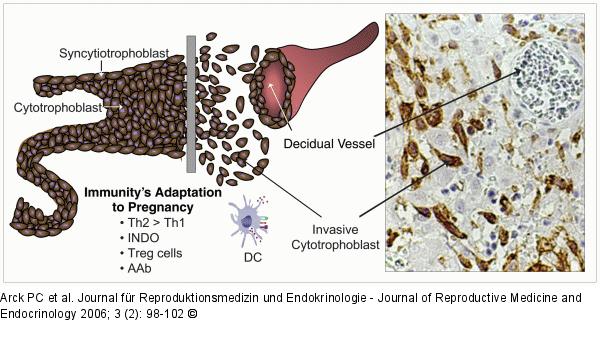Arck PC, Knackstedt MK, Blois SM Current Insights and Future Perspectives on Neuro-Endocrine-Immune Circuity Challenging Pregnancy Maintenance and Fetal Health Journal für Reproduktionsmedizin und Endokrinologie - Journal of Reproductive Medicine and Endocrinology 2006; 3 (2): 98-102 Volltext (PDF) Summary Übersicht
| ||||||
Abbildung 3: Immunity´s adaption - Pregnancy Immunity’s adaptation to pregnancy. Spatial adjacencies of invasive “histoincompatible” cytotrophoblast cells and maternal immune cells at the interface of fetal and maternal tissues guarantees nourishment of the fetus, but may provoke fetal rejection. Such spatial adjacencies are displayed on the left part of the figure, the right part reveals the in situ appearance in human deciduas basalis at gestation week 10, invasive trophoblast cells have been labelled by immunohistochemistry employing anti-cytokeratin antibody (magnification ×40). Tolerance mechanisms evolve in the process of immunity’s adaptation to pregnancy comprise the predominance of anti-inflammatory, Th2 cytokines over pro-inflammatory Th1 cytokines, the decidual expression of indoleamine 2, 3-dioxygenase (INDO), the presence of CD4+CD25bright regulatory T (Treg) cells, and the synthesis of asymmetric IgG antibodies (AAbs). In addition, it has become apparent in the past few years that dendritic cells (DCs) seem to be an essential regulatory cell subset at the feto-maternal interface in mediating tolerance. |

Abbildung 3: Immunity´s adaption - Pregnancy
Immunity’s adaptation to pregnancy. Spatial adjacencies of invasive “histoincompatible” cytotrophoblast cells and maternal immune cells at the interface of fetal and maternal tissues guarantees nourishment of the fetus, but may provoke fetal rejection. Such spatial adjacencies are displayed on the left part of the figure, the right part reveals the in situ appearance in human deciduas basalis at gestation week 10, invasive trophoblast cells have been labelled by immunohistochemistry employing anti-cytokeratin antibody (magnification ×40). Tolerance mechanisms evolve in the process of immunity’s adaptation to pregnancy comprise the predominance of anti-inflammatory, Th2 cytokines over pro-inflammatory Th1 cytokines, the decidual expression of indoleamine 2, 3-dioxygenase (INDO), the presence of CD4+CD25bright regulatory T (Treg) cells, and the synthesis of asymmetric IgG antibodies (AAbs). In addition, it has become apparent in the past few years that dendritic cells (DCs) seem to be an essential regulatory cell subset at the feto-maternal interface in mediating tolerance. |



